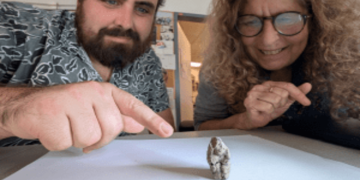ARCHAEOLOGISTS have uncovered an “anomaly” which could reveal a secret portal underneath the tombs of Pharaohs.
Researchers studying the area surrounding the famous Pyramids of Giza in Egypt detected the anomaly after using advanced geophysical techniques to examine the area near the Western Cemetery, where the royal and elite members of ancient Egyptian society were buried.

The area the archeologists have been surveying[/caption]

The area the archeologists have been surveying[/caption]
The team, made up of Japanese and Egyptian archaeologists, discovered an L-Shaped structure buried beneath the surface, whilst using using ground-penetrating radar (GPR) and electrical resistivity tomography (ERT).
These non-invasive methods are a way for researchers to examine underground structures without the need for evacuation.
GPR works by sending radar pulses into the ground and measuring how long it takes them to return, thus helping to create images of subsurface structures.
ERT uses electrical resistance to map underground materials, and together, both of these techniques are great for providing a detailed view on the underground and detecting anomalies.
The L-shaped structure is 6.5 feet underground, and has sharp, defined angles, suggesting it was man-made.
Researchers say that the shape is not recognisable as any known architectural feature from Giza, leading them to believe it could be an entrance to a deeper structure or chamber.
Below the L-shaped structure, a “highly electrically resistive,” anomaly has been detected meaning it doesn’t conduct electricity in the same way as the materials surrounding it.
Anomalies like this can indicate the presence of substances such as sand, gravel, or voids in the earth, which could mean there is a hidden passage or chamber below the surface.
Further investigation will have to be carried out to determine what exactly the anomaly is.
If it is found that there is a hidden chamber or passageway, this will deepen our understanding of Egyptian burial practices, and construction techniques used by the ancient society.
‘Ice mummy’
This comes as the intricate tattoos of a 2,500-year-old Siberian “ice mummy” have finally been revealed through high-tech imaging.
The designs reveal leopards, tigers, a stag, a rooster and even some long-lost mythical creatures.
They are so detailed that even a modern tattooist would struggle to reproduce them, according to the researchers behind the discovery.
The tattoos belong to a woman who was about 50-years-old when she died.
A brief history of Ancient Egypt

Here's everything you need to know…
- The Ancient Egyptians were an advanced civilisation who at one point ruled over a huge portion of the globe
- The civilisation was founded about 5,000 years ago when ancient people set up villages along the River Nile
- It lasted for about 3,000 years and saw the building of complex cities centuries ahead of their time – as well as the famous Great Pyramids
- The Ancient Egyptians were experts at farming and construction
- They invented a solar calendar, and one of the world’s earliest writing systems: The hieroglyph
- The Egyptians were ruled by kings and queens called pharaohs
- Religion and the afterlife were a huge part of Ancient Egyptian culture. They had over 2,000 gods
- Pharaohs built huge elaborate tombs to be buried in, some of which were pyramids – at the time among the largest structures in the world
- The Egyptians believed in life after death, and important people’s corpses were mummified to preserve their bodies for the afterlife
- The Ancient Egyptian empire fell in 30BC due to a mix of factors, including wars with other empires and a 100-year period of drought and starvation
She is thought to have belonged to the nomadic horse-riding Pazyryk culture, which roamed the lands between China and Europe.
The scans exposed “intricate, crisp and uniform” tattooing that could not be seen with the naked eye.
Over the two millennia, the ink has become all but invisible on the body as the skin darkens with time.
“The insights really drive home to me the point of how sophisticated these people were,” lead author Dr Gino Caspari from the Max Planck Institute of Geoanthropology and the University of Bern, told BBC News.
Archaeologists worked with researcher Daniel Riday, a tattooist who reproduces ancient ink on his own body to understand how they were made.
Tattooing was likely widespread during prehistory, but few remains from that era are preserved well enough to investigate.




























